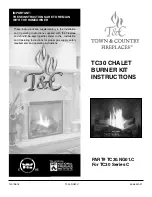
EN
31
6. Spread the lava stones in a uniform layer
in the tray. Make sure that the burner is
covered by the lava stones, but do not
cover the ignition screen.
The gas might not ignite if the ignition screen
is covered by lava stones.
7. Turn the control on the gas cylinder valve
clockwise to turn off the gas from the
cylinder.
8. Screw the control in the gas cylinder valve
by hand. Check that it is firmly tightened.
USE
IGNITION
1. Always check the hose before use.
Replace the hose if it is worn or damaged.
2. Turn the control on the gas cylinder valve
anticlockwise to open the gas.
FIG. 2
3. Press in the electric igniter. Press in and
turn at the same time the control dial
anticlockwise to LOW. Keep the control
dial pressed to light the burner.
4. Release the electric igniter when the
burner is lit. Keep the control dial pressed
for another 45 seconds.
5. If the burner does not light within a few
seconds, press and turn the control dial to
OFF. Wait 5 minutes and then try to light
the product again according to the above
instructions.
WARNING!
Gas will flow out through the burner if the
valve is open and the burner has not lit,
and can ignite by mistake – risk of serious
personal injury.
IMPORTANT:
• Note the height of the flame when the
burner has lit.
• The flame should be yellow/blue and 5
to 25 cm high.
Total nominal
heat output PL
18,5 kW / 1346.2 g/h
Ignition Integrated
Air supply
Not adjustable
Weight
32 kg
Size
101 x 51 x 48 cm
DESCRIPTION
1. Ignition screen
2. Thermo element
3. Base plate
4. Earth wire
5. Ignition element
6. Base unit
7. Lava stones
8. Type plate
9. Pulse ignition
10. Knob
11. Burner
12. Injector
13. Flexible tube
14. Gas valve
15. Glass (long side)
16. Glass holder
17. Glass (short side)
FIG. 1
INSTALLATION
1. Open the pack and unpack all the parts.
2. Make sure that the gas tap on the product
is closed.
3. Remove the protective plastic on the
supplied AAA battery.
4. Remove the rubber cap on the electric ignitor
and put the AAA battery in the battery holder.
Insert the battery with the positive terminal
pointing towards the rubber cap.
5. Screw on the rubber cap.




































